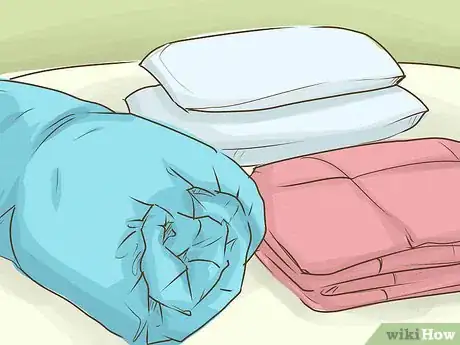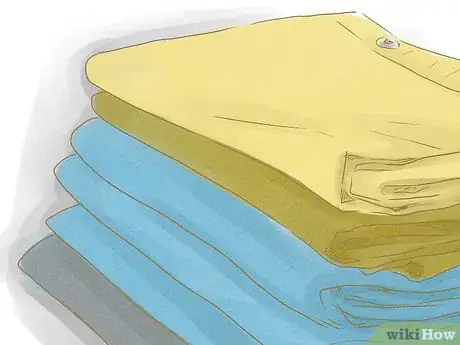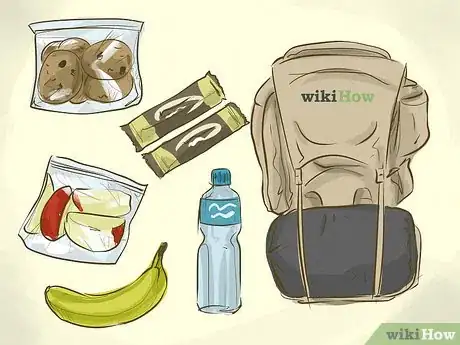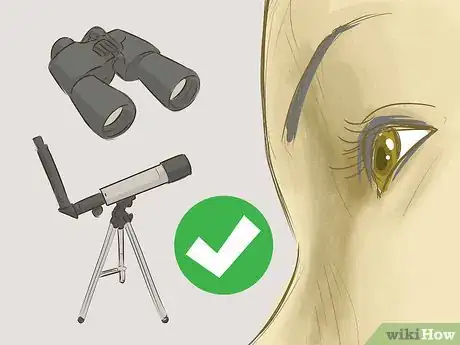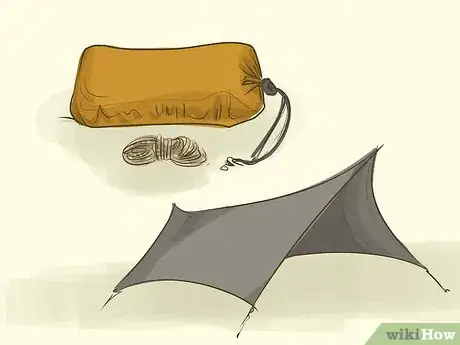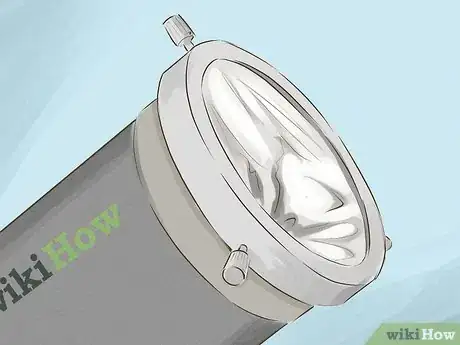This article was co-authored by wikiHow Staff. Our trained team of editors and researchers validate articles for accuracy and comprehensiveness. wikiHow's Content Management Team carefully monitors the work from our editorial staff to ensure that each article is backed by trusted research and meets our high quality standards.
There are 10 references cited in this article, which can be found at the bottom of the page.
This article has been viewed 158,373 times.
Learn more...
Stargazing can be a rewarding and engaging activity when done right. Knowing when, where, and how to stargaze is key to a comfortable experience. So, the next time the night sky is clear and you want to go out stargazing for an hour or more, gather your comfortable clothing and blankets, and lay back and enjoy!
Steps
Gathering Comfort Supplies
-
1Layer your clothing. Depending on the time of year, you’ll need to bring a variety of clothing with you, as your body temperature will drop the longer you sit still. Likewise, you might get warm and want to shed a few layers.
- If you stargaze in the fall or winter, try thermal underwear, sweaters, hats, gloves or mittens, and scarves.
- If you stargaze in the spring or summer, wear multiple, light layers. Try a zip-up hoodie, light jacket, hat, and jeans. Bring one warm coat in case the temperature drops dramatically during the night.
-
2Bring a mat, chair, and pillow. You will want to keep your eyes trained on the sky for an extended period of time, so comfort is a must. Your neck will become tired and sore very quickly unless you lay flat on your back or recline in a chair.
- Good options for comfort and warmth are: a yoga mat, pillows, tarp (in case of dew or damp grass), camping pad, camping chair, or reclining deck chair.[1]
- If prefer to sit up, remember to put something between yourself and the ground so that you don’t catch a chill.
Advertisement -
3Use a blanket for comfort and warmth. Bringing a blanket or two will both keep you warm and add a layer of cushioning to your chair, mat, or tarp. Sit under or on top of a blanket, or bundle it under your head for extra support.
- Don’t bring blankets that are not washable. Anything you bring with you while stargazing may get dirty or wet, since you will be outdoors.
-
4Pack food and drinks. You may be out for a while, so it’s important to supply yourself with snacks and beverages. Sustenance can be both fun and practical, so remember to pack things that you like!
- Popular beverage options are: hot chocolate, coffee, tea (especially during the colder months), water, soda, and beer or wine (if you are over 21 and have a designated driver).
- Portable, energy-filled foods you might want to bring are: trail mix, granola bars, chocolate, beef jerky, soup in a thermos, or pre-made sandwiches.
-
5Relax your eyes by bringing binoculars. Binoculars will help you see more stars, planets, and constellations than you would with your naked eye. This way, you won’t strain your eyes trying to see everything that’s up there.[2]
-
6Try a tent or canopy for longer stargazing trips. If you think you’ll be out stargazing for a while, or are worried about the weather, bring a tent, canopy, or tarp that you can set up. This way, you’ll have shelter from the elements and can take a rest if you’re feeling tired or worn out. You can also store your extra snacks, drinks, chairs, and blankets underneath the covering.[3]
Getting Ready to Stargaze
-
1
-
2Stargaze in the summertime. Summer nights (during June, July, and August) can offer great stargazing conditions. You’ll also be more comfortable than you would be in the winter, and can pack a bit lighter.[6]
- You are most likely to see meteor showers in the summertime. The “Perseids” meteor shower is awe-inspiring, and visible from nearly everywhere in the Northern Hemisphere. It occurs every August.[7]
- Some constellations that can be seen year-round (meaning they are “circumpolar”) are: Cassiopeia, Ursa Major, and Cepheus.[8]
-
3Get out of the city for the most relaxation. Try to avoid major cities and densely populated areas. Stargazing will be difficult in these areas because of the light pollution and noise they produce. For a relaxed stargazing experience, you’ll want to find some peace and quiet, likely in a more rural area. [9]
-
4Watch out for wildlife. If you are able to find a sparsely populated, rural area to stargaze in, chances are good that some wildlife will be around. Deer, bears, coyotes, raccoons, and possums are common camp-crashers. Research what animals are found in your area, and keep a sharp eye out while you are outside at night. [10]
- Wherever you decide to stargaze, always bring bug spray. You certainly won’t be comfortable if you’re swatting at mosquitos all night!
- You can bring a bright floodlight or something to make loud noises with, to deter animals that may come near while you are stargazing.
Seeing the Stars
-
1Bring a friend or family member along. This is a good safety precaution, in case you lose your way in the dark or are nervous about being alone at night. You are also likely to spot more stars with two sets of eyes.
-
2Set up on level ground. Arrange your tent, chairs, blankets, snacks, and drinks on an even surface and make sure that everything is within arm’s reach of you. This way, you won’t have to fumble around too much, and you won’t risk losing anything in the dark.
- Remember to clean up after yourself, both to avoid animal encounters and to protect the environment.
-
3Position your head at a 30 degree angle to the ground. This way you won’t strain your neck as you look up at the stars, and you will mimic the comfort of lying in bed. Do this by using a pillow, re-positioning your reclining chair, or bundling a blanket beneath your head.
- You can also try lying completely flat on the ground, for a fuller view of the sky. Some people find this posture slightly harder to get up from, however.
-
4Use an infra-red flashlight to relax your eyes. You will need to turn off your regular light once you have set up your area, in order to stargaze.[11] But, if you need to look around after doing so, you should use an infra-red light to avoid having to re-adjust your eyes to the darkness. A red light is easier on the eyes, and will not disturb your stargazing environment.
- Your eyes will need anywhere from five to thirty minutes to adjust to the darkness, and turning a bright, white light off and on will deter this adjustment process.
- You can cover your regular flashlight with red cellophane, rather than buying an infra-red light.[12]
-
5Put less strain on your eyes. Try using the "averted vision” method of seeing stars and constellations, which may be useful if you find it hard to spot faint stars. Rather than straining your eyes, look just to the side of what you're trying to see. Your peripheral vision is more sensitive to light and dark, making it easier to see faint objects when the rest of the sky appears gray.[13]
-
6Enjoy yourself! Stargazing can be a fun, rewarding experience whether you are an amateur or expert stargazer. Lay back, have a snack, talk to a friend, and observe the night sky as you wouldn't normally be able to.
Things You'll Need
- Suitable clothing
- Binoculars
- Flashlight with red cellophane or infra-red flashlight
- Snacks and drinks
- Comfortable things to sit and lie on
References
- ↑ https://www.accuweather.com/en/weather-blogs/astronomy/stargazing-for-beginners-planning-your-first-night-out/63296
- ↑ https://www.accuweather.com/en/weather-blogs/astronomy/stargazing-for-beginners-planning-your-first-night-out/63296
- ↑ http://www.astronomy.com/community/from-the-industry/2013/08/what-to-bring-for-a-night-of-stargazing-the-ultimate-guide
- ↑ http://www.amazingtelescopes.com/best-stargazing-conditions/
- ↑ http://mentalfloss.com/article/66316/13-tips-stargazing-astronomers
- ↑ https://nightsky.jpl.nasa.gov/news-display.cfm?News_ID=729
- ↑ http://earthsky.org/?p=165416
- ↑ http://www.polaris.iastate.edu/NorthStar/Unit9/unit9_sub2.htm
- ↑ http://curious.astro.cornell.edu/about-us/116-observational-astronomy/stargazing/professional-observers/712-how-does-light-pollution-affect-astronomers-intermediate
- ↑ http://www.astronomy.com/community/from-the-industry/2013/08/what-to-bring-for-a-night-of-stargazing-the-ultimate-guide
- ↑ http://hyades.wordpress.com/2007/10/18/stargazing-tips-make-the-most-of-a-starry-night/
- ↑ https://www.accuweather.com/en/weather-blogs/astronomy/stargazing-for-beginners-planning-your-first-night-out/63296
- ↑ http://hyades.wordpress.com/2007/10/18/stargazing-tips-make-the-most-of-a-starry-night/
- ↑ https://www.eekwi.org/articles/winter-stargazing
About This Article
To stargaze comfortably, layer up with thermal underwear, a sweater, hat, and gloves to stay warm. Additionally, make sure to bring a mat or chair, as you may be sitting for a long time. For extra warmth and comfort, try bringing a blanket to lay on top of your seat. Finally, don’t forget to bring a snack and something to sip on while you stargaze. To learn about the best times of the year to stargaze, read on!

